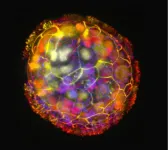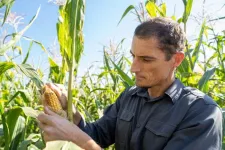(Press-News.org) (Santa Barbara, Calif.) — Flames roared through Santa Barbara County in late 2017. UC Santa Barbara canceled classes, and the administration recommended donning an N95, long before the COVID pandemic made the mask a household item. Smoke and ash choked the air, but the Thomas Fire’s effects weren’t restricted to the land and sky. Huge amounts of ash settled into the oceans, leaving researchers to wonder what effect it might have on marine life.
Now scientists at UC Santa Barbara have discovered that wildfire ash adds nutrients to marine systems, and that microbes at the base of the food web can use these nutrients to grow. This contrasts with the impacts of ash in freshwater ecosystems, where it is often toxic. The results appear in the Proceedings of the Royal Society B.
With a major fire scorching the region, researchers at UCSB were curious about the impact of ash on coastal ecosystems. Unfortunately, the only marine studies they could find were on volcanic ash, which has a very different chemical composition. Meanwhile, studies of wildfire ash focused on freshwater ecosystems, where the overwhelming amount of debris often has a toxic effect.
With a research cruise already on the calendar, the team jumped on the opportunity to investigate. “We planned this out in just a few weeks,” said lead author Tanika Ladd, a doctoral student at the time. “The fire broke out Dec. 4; our cruise was scheduled to go out on Dec. 17, and this clearly wasn’t in our plans for all of the cruise prep before the fire started.” The group quickly pivoted the entire cruise itinerary. Senior scientists sent off a flurry of grant applications, and the team revised the schedule a couple weeks before setting sail.
Eleanor Arrington, a former doctoral student at UCSB, collected ash from car windshields around town and mixed it into a saltwater solution for about 24 hours before filtering out the solid ash particles. They then poured different concentrations of the remaining leachate into seawater cultures and incubated them on deck for four days.
Measurements revealed that particulate organic carbon, a proxy for biomass, had increased significantly in samples with more ash leachate relative to the controls. This suggested that plankton were growing more in those samples, and drawing carbon from the atmosphere into the water via photosynthesis.
Ladd also analyzed the nutrients dissolved in the samples. The ash enriched the seawater, especially with nitrate, nitrite and ammonium, tasty sources of nitrogen for all of your photosynthetic needs. Dissolved organic nitrogen also increased. The samples with leachate had more silicic acid as well, which is used by plankton like diatoms to make their microscopic shells.
The ash also added metals to the seawater, such as copper and iron. Metals can be a mixed blessing for life. They’re necessary for biology, but are toxic in higher concentrations, which can occur in freshwater ecosystems.
Of course, the ocean is much bigger than a creek, river or lake, so ash is much more diluted in marine ecosystems. Ladd and her co-authors prepared their samples to reflect that. The sheer quantity of wildfire debris can also choke out freshwater ecosystems, a much lower risk in the ocean, where ash can settle to the bottom. Indeed, the team filtered their solution to control for light levels and other effects the particulate matter might have introduced. Overall, the researchers didn’t observe any harmful effects from the ash leachate.
This study provides some initial insights on the effect wildfire ash has on marine life. “Coastal ecosystems may have increased primary production during these wildfires,” Ladd said, “but we need to know what this actually means on a global scale.”
The impact of fires may vary depending on what’s burning and on local environmental conditions. For instance, the Santa Barbara Channel is often nitrogen limited, so ash could support a flush of growth off the California coast. Either way, fires transfer nutrients and energy from the land to the ocean, which warrants attention, especially as wildfire regimes change.
END
Thomas Fire research reveals that ash can fertilize the oceans
Quick-thinking researchers at UC Santa Barbara took advantage of the fire to learn how ash affects ocean ecosystems
2023-11-30
ELSE PRESS RELEASES FROM THIS DATE:
Study tests firefighter turnout gear with, without PFAS
2023-11-30
Transitioning away from per- and polyfluoroalkyl substances (PFAS), which offer water- and oil-repelling properties on the outer shells of firefighter turnout gear, could bring potential performance tradeoffs, according to a new study from North Carolina State University.
The study showed that turnout gear without PFAS outer shell coatings were not oil-repellent, posing a potential flammability hazard to firefighters if exposed to oil and flame, said Bryan Ormond, assistant professor of textile engineering, chemistry and science at NC State and corresponding author of ...
New study uses genetic data to support use of thiazide diuretics for kidney stone prevention
2023-11-30
Kidney stones affect nearly 10% of the global population. For more than three decades, thiazide diuretics, a common medication used for high blood pressure, have been the standard of care for kidney stone prevention because they reduce the excretion of urinary calcium.
However, recent clinical trials have raised doubts about their efficacy in preventing kidney stones. The NOSTONE trial, published in The New England Journal of Medicine in March 2023, failed to find a protective effect of thiazide diuretics on kidney stone disease.
A ...
Study identifies key algae species helping soft corals survive warming oceans
2023-11-30
BUFFALO, N.Y. --- Scleractinian corals, or hard corals, have been disappearing globally over the past four decades, a result of climate change, pollution, unsustainable coastal development and overfishing. However, some Caribbean octocorals, or soft corals, are not meeting the same fate.
During a two-year survey of soft corals in the Florida Keys, Mary Alice Coffroth, professor emerita of geology at the University at Buffalo, along with a small team of UB researchers, identified three species of octocorals that have survived heat waves. While the coral animal itself may be ...
Scientists build tiny biological robots from human cells
2023-11-30
Researchers at Tufts University and Harvard University’s Wyss Institute have created tiny biological robots that they call Anthrobots from human tracheal cells that can move across a surface and have been found to encourage the growth of neurons across a region of damage in a lab dish.
The multicellular robots, ranging in size from the width of a human hair to the point of a sharpened pencil, were made to self-assemble and shown to have a remarkable healing effect on other cells. The discovery is a starting point for the researchers’ vision to use patient-derived ...
Smart microgrids can restore power more efficiently and reliably in an outage
2023-11-30
It’s a story that’s become all too familiar — high winds knock out a power line, and a community can go without power for hours to days, an inconvenience at best and a dangerous situation at worst. UC Santa Cruz Assistant Professor of Electrical and Computer Engineering Yu Zhang and his lab are leveraging tools to improve the efficiency, reliability, and resilience of power systems, and have developed an artificial intelligence (AI) -based approach for the smart control of microgrids for power ...
Unsafe lead levels in school drinking water: new UMass Amherst study IDs building risk factors
2023-11-30
AMHERST, Mass. – University of Massachusetts Amherst civil and environmental engineers have determined the factors that may help identify the schools and daycare centers at greatest risk for elevated levels of lead in drinking water. The most telling characteristic for schools in Massachusetts is building age, with facilities built in the 1960s and 1970s—nearly a third of the facilities tested—at the greatest risk for having dangerously high water lead levels.
There is no safe exposure ...
Chinstrap penguins asleep thousands of times per day, but only for seconds at a time
2023-11-30
In the wild, nesting chinstrap penguins get more than 11 hours of sleep per day – but not all at once. According to a new study, these birds nod off thousands of times per day, but for only around 4 seconds at a time, cumulatively accruing their daily sleep needs while remaining continuously vigilant over their nests. Sleep seems to be ubiquitous throughout the animal kingdom. Typically characterized by immobility and the relative loss of ability to sense and respond to the surrounding environment, sleep can render animals vulnerable to predation. In humans, insufficient sleep can lead to nodding off, the seconds-long interruption of wakefulness by eye closure, and sleep-related ...
A Neptune-mass exoplanet found closely orbiting a very low-mass M dwarf star
2023-11-30
The discovery of a Neptune-mass exoplanet orbiting the very low-mass M dwarf star LHS 3154 challenges theoretical models of planet formation, according to a new study. The planet, which has a mass at least 13 times that of Earth, tightly orbits a star 9 times less massive than the Sun, demonstrating that small stars can sometimes host larger planets than was previously thought. Planets form in the dense circumstellar discs of gas and dust that surround newborn stars. The amount of material in these structures determines how massive the planets that form ...
Two teosintes made modern maize
2023-11-30
Broad genetic sampling of maize and its teosinte grass ancestors reveals evidence of wild admixture during the crop’s initial domestication and dispersal, according to a new study. The findings clarify the contentious origin of modern maize and raise new questions about the anthropogenic mechanisms underlying its spread throughout the Americas. The domestication of crops transformed human culture. For many crops, the wild plants that modern domesticates are most closely related to can be readily identified by morphological and genetic similarities. Yet, despite its global agricultural importance, the ancestry of modern maize has long ...
A mixed origin made maize successful
2023-11-30
Maize is one of the world’s most widely grown crops. It is used for both human and animal foods and holds great cultural significance, especially for indigenous peoples in the Americas. Yet despite its importance, the origins of the grain have been hotly debated for more than a century. Now new research, published Dec. 1 in Science, shows that all modern maize descends from a hybrid created just over 5000 years ago in central Mexico, thousands of years after the plant was first domesticated.
The ...
LAST 30 PRESS RELEASES:
Implant provides lasting relief for treatment-resistant depression
Autologous T cell therapy targeting multiple antigens shows promise treating pancreatic cancer
First extensive study into marsupial gut microbiomes reveals new microbial species and antimicrobial resistance
Study debunks myth of native Hawaiians causing bird extinctions
Tailored biochar could transform how crops grow, resist disease, and clean polluted soils
Biochar-based enzyme technology offers new path for cleaner water and soil
Biochar helps farmland soils withstand extreme rain and drought by steadying carbon loss
New study reveals major gaps in global forest maps
Ochsner Health names Dr. Timothy Riddell executive vice president and chief operating officer
Can future-focused thoughts help smokers quit?
From brain scans to alloys: Teaching AI to make sense of complex research data
Stem Cell Reports seeks early career editors to join the editorial board
Signs of ancient life turn up in an unexpected place
Pennington Biomedical researchers explore factors behind body’s ability to regulate weight
Zhongping Lee awarded the Nils Gunnar Jerlov Medal
Deborah S. Kelley awarded the Wallace S. Broecker Medal
Novel immunotherapy demonstrates early potential to overcome resistance to immune checkpoint therapy
LLM treatment advice agrees with physician recommendations in early-stage HCC, but falls short in late stage
Deep learning model trained with stage II colorectal cancer whole slide images identifies features associated with risk of recurrence – with higher success rate than clinical prognostic parameters
Aboard the International Space Station, viruses and bacteria show atypical interplay
Therapies that target specific type of cell death may be an effective avenue for cancer treatment, UTHealth Houston researchers find
CHEST releases guideline on biologic management in severe asthma
Scientists create a system for tracking underwater blackouts
Fruit fly pigmentation guides discovery of genes that control brain dopamine and sleep
World's largest physics conference to be held in Denver and online this March
New mega-analysis reveals why memory declines with age
Understanding ammonia energy’s tradeoffs around the world
UTHealth Houston researchers map gene disruptions in sporadic early onset Alzheimer’s disease across key brain regions
Minimum wage increases are linked to safer pregnancies
Left in the cold: Study finds most renters shut out of energy-saving upgrades
[Press-News.org] Thomas Fire research reveals that ash can fertilize the oceansQuick-thinking researchers at UC Santa Barbara took advantage of the fire to learn how ash affects ocean ecosystems




